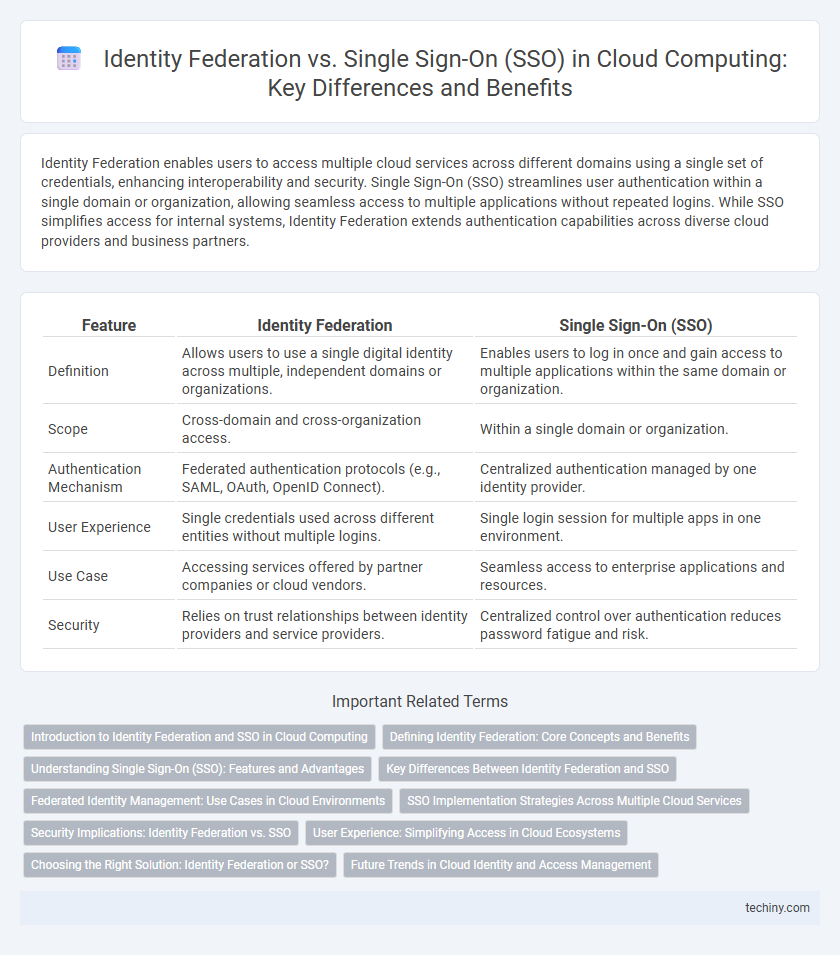Identity Federation enables users to access multiple cloud services across different domains using a single set of credentials, enhancing interoperability and security. Single Sign-On (SSO) streamlines user authentication within a single domain or organization, allowing seamless access to multiple applications without repeated logins. While SSO simplifies access for internal systems, Identity Federation extends authentication capabilities across diverse cloud providers and business partners.
Table of Comparison
| Feature | Identity Federation | Single Sign-On (SSO) |
|---|---|---|
| Definition | Allows users to use a single digital identity across multiple, independent domains or organizations. | Enables users to log in once and gain access to multiple applications within the same domain or organization. |
| Scope | Cross-domain and cross-organization access. | Within a single domain or organization. |
| Authentication Mechanism | Federated authentication protocols (e.g., SAML, OAuth, OpenID Connect). | Centralized authentication managed by one identity provider. |
| User Experience | Single credentials used across different entities without multiple logins. | Single login session for multiple apps in one environment. |
| Use Case | Accessing services offered by partner companies or cloud vendors. | Seamless access to enterprise applications and resources. |
| Security | Relies on trust relationships between identity providers and service providers. | Centralized control over authentication reduces password fatigue and risk. |
Introduction to Identity Federation and SSO in Cloud Computing
Identity Federation in cloud computing enables users to access multiple cloud services across different domains using a single set of credentials, streamlining authentication processes and enhancing security. Single Sign-On (SSO) allows users to authenticate once and gain access to multiple applications within the same domain without re-entering credentials. Both Identity Federation and SSO improve user experience and reduce administrative overhead, but Identity Federation extends authentication across distinct organizations or cloud providers.
Defining Identity Federation: Core Concepts and Benefits
Identity Federation enables users to access multiple cloud services across different domains using a single set of credentials by establishing trust relationships between identity providers and service providers. This core mechanism simplifies user authentication processes, enhances security through centralized identity management, and reduces password fatigue by minimizing the need for multiple logins. Key benefits include seamless user experience, improved compliance with regulatory requirements, and scalable access control for diverse cloud environments.
Understanding Single Sign-On (SSO): Features and Advantages
Single Sign-On (SSO) enables users to access multiple applications with a single set of login credentials, enhancing user convenience and security by reducing password fatigue and minimizing authentication errors. Key features include centralized authentication, seamless user experience across platforms, and integrated access management, making it ideal for organizations with diverse cloud environments. Advantages of SSO in cloud computing encompass improved user productivity, reduced IT helpdesk costs, and strengthened security posture through consistent enforcement of access policies.
Key Differences Between Identity Federation and SSO
Identity Federation enables users to access multiple systems across different organizations using a single set of credentials, facilitating trust and seamless interaction between distinct identity providers. Single Sign-On (SSO) allows users to authenticate once and gain access to multiple applications within the same organization or domain without re-entering credentials. The key difference lies in scope: Identity Federation operates across organizational boundaries, whereas SSO functions within a single domain or enterprise environment.
Federated Identity Management: Use Cases in Cloud Environments
Federated Identity Management enables seamless access across multiple cloud service providers by linking user identities from different domains, enhancing security and user experience in multi-cloud environments. Use cases include secure collaboration between enterprises, enabling third-party access while maintaining centralized identity control, and supporting hybrid cloud models where on-premises and cloud resources coexist. This approach reduces administrative overhead and mitigates risks associated with managing multiple credentials across diverse platforms.
SSO Implementation Strategies Across Multiple Cloud Services
SSO implementation strategies across multiple cloud services often leverage identity federation protocols like SAML, OAuth, and OpenID Connect to enable seamless authentication without duplicating credentials. Centralized Identity Providers (IdPs) manage user access and enforce consistent security policies across diverse cloud platforms, reducing administrative overhead and enhancing user experience. Implementing robust token management, multi-factor authentication (MFA), and trust frameworks ensures scalable and secure SSO integration in complex cloud environments.
Security Implications: Identity Federation vs. SSO
Identity Federation enhances security by allowing users to access multiple systems across different organizations using a single trusted identity provider, reducing password proliferation and minimizing attack surfaces associated with credential management. Single Sign-On (SSO) simplifies user access within a single domain or organization but risks extended session vulnerabilities if a single set of credentials is compromised. Implementing Identity Federation often involves stronger authentication protocols and trust frameworks, improving cross-domain security compared to traditional SSO models.
User Experience: Simplifying Access in Cloud Ecosystems
Identity Federation and Single Sign-On (SSO) both streamline user access in cloud ecosystems by reducing password fatigue and login barriers. Identity Federation enables seamless cross-domain authentication across multiple organizations or cloud services, while SSO consolidates access within a single domain or service provider. Enhancing user experience hinges on adopting the right solution that balances convenience, security, and support for diverse cloud applications.
Choosing the Right Solution: Identity Federation or SSO?
Choosing between Identity Federation and Single Sign-On (SSO) depends on organizational needs for cross-domain access and security. Identity Federation enables seamless authentication across multiple, distinct security domains by leveraging standards like SAML or OAuth, ideal for partnerships and multi-cloud environments. SSO simplifies user experience within a single domain by allowing one-time authentication across interconnected applications, optimizing internal access management without external identity trust challenges.
Future Trends in Cloud Identity and Access Management
Emerging trends in cloud identity and access management emphasize the integration of identity federation with enhanced single sign-on (SSO) capabilities to provide seamless cross-domain authentication and unified user experiences. Advances in decentralized identities and blockchain technology are expected to bolster trust frameworks, enabling more secure and privacy-preserving federated identity models. The widespread adoption of AI-driven adaptive authentication will further optimize access control by dynamically assessing context and risk across federated systems.
Identity Federation vs SSO (Single Sign-On) Infographic

 techiny.com
techiny.com